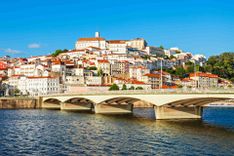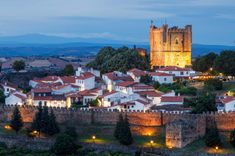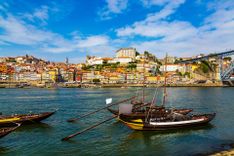Planning your own trip? Prepare for your trip
Use Rough Guides' trusted partners for great rates
- Algarve
- Albufeira
- Portugal
Plan and book your private, tailor-made tour with vetted local experts
Albufeira has been one of the Algarve’s busiest resorts for decades, and it shows. The old town still charms with its whitewashed houses perched on sandstone cliffs above a broad beach, but much of the surrounding area has been given over to sprawling hotels, bars, and holiday apartments. The marina, painted in bright candy colors, feels more theme park than fishing port, and the yachts lined up outside are anything but subtle.
If you are looking for quiet or unspoiled Portugal, this is not the place. What Albufeira offers instead is energy: buzzing nightlife, a beach scene that runs from sunrise to well past midnight, and a mix of visitors who come for the sun, the sand, and the party.

Hey, I’m Sara, your Portugal travel expert, and I’ve been exploring the Algarve for years. Albufeira is one of those places that divides opinion, but there’s no denying its pull. The old town, with its whitewashed streets above the beach, still has postcard charm, while the rest of Albufeira is unapologetically built for fun: neon-lit bars, late-night clubs, and more restaurants than you could count. This Albufeira travel guide gives you the essentials: how to get there, what to see, and where to stay.
The best way to approach Albufeira is with an open mind. Spend mornings on the sand at Praia dos Pescadores, take a boat trip to sea caves, and wander through the narrow lanes of the old town. When the sun sets, the Strip explodes with nightlife, while quieter spots like Praia da Oura or the marina offer a different rhythm. The obvious draws are easy to spot: beaches, boat tours, and bars. But look closer and you’ll also find tiled chapels, fishing boats pulled up on the sand, and seafood restaurants that still serve the catch of the day.
Sara’s tip
Skip the midday crowds on the main beach and take an early morning walk along Praia dos Pescadores. You’ll share the sand with fishermen bringing in their nets and have the cliffs glowing gold in the first light.
Best time to visit
Spring from April to June is the best time to visit Albufeira, with warm weather and fewer crowds. July and August are the busiest months, when Albufeira turns into one big beach party. September and October stay warm but feel calmer, with sea temperatures at their best. Winter is quiet, with mild days and cooler evenings, perfect if you want the beaches almost to yourself.
How to get to Albufeira
The nearest airport is Faro, about 40 minutes away by car. From Faro Airport, you can book a shuttle, take a taxi, or rent a car for more freedom. Trains and buses also run from Faro and Lisbon, with the journey from Lisbon taking around three hours. Driving is straightforward, and parking is easier at hotels outside the old town.
Best areas to stay in Albufeira
Albufeira sits on Portugal’s southern coast in the Algarve, about 40 kilometers west of Faro and 250 kilometers south of Lisbon. It takes around 40 minutes to drive from Faro Airport or about three hours from Lisbon.
Often listed among the best places to visit in Portugal, Albufeira is known for its sandy beaches, lively nightlife, and colorful marina. From here, you can join boat trips to the Benagil caves, explore quieter coves along the Algarve coast, or head inland to discover traditional villages and vineyards.
















Albufeira is spread out, with the old town, the Strip, the marina, and several beaches scattered along the coast. Walking works well in the old center, but you will need wheels of some kind to reach the beaches further out or to move between neighborhoods.

Albufeira, Portugal © R. Nagy / Shutterstock
Albufeira has no shortage of places to stay, from budget apartments to all-inclusive resorts. Your best area depends on whether you are here for nightlife, beaches, or family downtime. Here’s where to base yourself depending on how you like to travel.

An evening view of Albufeira, Algarve region, Portugal
Albufeira is the Algarve’s best-known resort, but it offers more than late nights and crowded sands. You’ll find hidden coves, cliff walks, fishing-village echoes, and easy access to some of the region’s wild interior. Here’s a deeper look at the best things to do in Albufeira, each one worth slowing down for.
Albufeira’s main beach, Praia dos Pescadores, sits at the foot of the old town, a wide strip of sand that once doubled as the town’s fishing harbor. Brightly painted boats used to line the shore here; today, you’ll find parasols, cafés, and families spreading towels across the sand. The cliffs form a natural amphitheater that glows golden at sunrise and deep orange by sunset.
It is one of the busiest stretches in high season, but it’s also a contender for the best beaches in Portugal if you consider atmosphere, convenience, and sheer scale. For a quieter feel, come early morning, when locals walk their dogs and the fishing boats head out to sea.
Step into Albufeira’s cobbled lanes and you’ll find a maze of whitewashed houses, tiled facades, and balconies spilling geraniums. At first glance, it feels touristy, with plenty of bars and souvenir shops, but look closer and the old village still peeks through. Small chapels like Igreja Matriz and São Sebastião recall centuries of faith, while locals still gather in Praça da República for evening coffee.
The old town changes character throughout the day. Mornings are calm, afternoons bustle with beachgoers spilling into the streets, and evenings bring musicians, street performers, and packed terraces. It’s best explored without a plan: follow the lanes uphill for sea views or down toward hidden corners where cats nap on stone steps.
The coastline east of Albufeira is lined with sea caves, arches, and sheltered coves, the most famous being the Benagil Cave. Its dome-like ceiling pierced by a natural skylight makes it one of the Algarve’s most photographed spots. Tours leave from Albufeira Marina and usually include dolphin-spotting on the open sea.
For the most memorable experience, opt for an early-morning departure. The water is calmer, light streams directly through the cave’s opening, and you’ll avoid the busiest crowds. Bring a hat and sunscreen; there is no shade on the boats, and keep your camera ready, because this is one of the Algarve’s defining sights.

Benagil Cave @ Shutterstock
Painted in pastel blocks of turquoise, yellow, and pink, the marina looks like someone dropped a Lego set by the water. Love it or hate it, it’s pure Albufeira: flashy yachts, cocktail bars, and bright lights after dark. Families find plenty of diversions here, from mini-golf to ice cream stalls, while couples might prefer a sunset drink on a quiet terrace.
Most boat trips leave from here, so even if you don’t linger, you’ll probably pass through. For a less touristy experience, come at dusk when the neon softens and the reflections shimmer across the water.
Avenida Sá Carneiro, better known as the Strip, is nightlife central. Neon lights, karaoke, booming clubs, and all-night bars pull in a young, international crowd. It’s noisy, chaotic, and unapologetic. If you want to dance until dawn, this is the place.
Start with cheap cocktails or a round of sangria at one of the open-air terraces, then head to late-night clubs like Kiss or Libertos. If partying isn’t your scene, steer clear after dark and instead enjoy the quieter wine bars and fado houses in the old town.
Beyond the main town sands, Albufeira hides some of the best beaches in the Algarve. Praia de São Rafael is a standout, a cove framed by honey-colored cliffs riddled with arches and sea stacks. Praia da Coelha is smaller, more intimate, with clear turquoise water perfect for swimming. Head west to Galé or Salgados for long open beaches where you can walk for miles at sunset.
Each beach has its character: family-friendly, romantic, or windswept and wild, and discovering them is part of the fun. Many have beach bars serving grilled sardines and vinho verde, so you can make a day of it without leaving the sand.
Amid the souvenir shops and tourist bustle, Albufeira still has pockets of calm. Igreja Matriz, with its neoclassical façade, offers a cool refuge in summer heat. Igreja de São Sebastião is smaller but striking, with a Manueline doorway and azulejo-tiled interior. These churches remind you that Albufeira was once a quiet fishing town, long before package holidays.
Pop in for a short pause between sightseeing. You might even find a local mass in progress, which gives a glimpse of daily life beyond the resort image.

Beach of São Rafael in Albufeira, Algarve, Portugal © Shutterstock
Seafood here is about freshness and simplicity. Cataplana de marisco, a seafood stew cooked in a copper pan, is a signature dish. Grilled sardines are a summer staple, often eaten with hands and bread to mop up the juices. For something richer, try arroz de marisco: a steaming pot of rice, prawns, and clams, fragrant with garlic and cilantro.
Skip the flashy tourist menus on the beachfront and head to backstreet tascas where families still run the kitchens. Prices are lower, flavors are better, and the welcome is warmer.
When the beaches get too busy, head inland. Jeep safaris from Albufeira bounce along dirt tracks through orange groves, cork forests, and hilltop villages. Guides often stop for tastings of medronho, a potent brandy distilled from arbutus berries, and honey made in the hills.
It’s a chance to see the Algarve’s rural side, quieter, slower, and a world away from the Strip. Spring is especially beautiful, with wildflowers covering the hillsides.
The Algarve’s cliffs are at their most dramatic in the evening, when the sun drops into the Atlantic and the rocks blaze orange. Sunset cruises leave from the marina, often with sangria or champagne included. As you drift past caves and coves, the views feel completely different from the daytime, with the coastline turning into a natural stage for the setting sun.
It is romantic, relaxing, and the perfect way to close a day in Albufeira. Some travelers head to a quiet seafood dinner afterwards, while others go straight into the nightlife of the Strip.

Albufeira, the Algarve, Portugal @ Shutterstock
Albufeira has a classic Mediterranean climate with long, dry summers and mild, wetter winters. On the Algarve coast, it is warmer and sunnier than much of the country, with fewer rainy days than Lisbon or Porto. Average temperatures range from around 52°F (11°C) in January to 84°F (29°C) in August. Sea breezes take the edge off the heat in midsummer, while winters are comfortable enough for beach walks. If you are planning around the best time to visit Portugal, Albufeira is at its most appealing in spring and autumn, when the weather is mild and the crowds are thinner. For current forecasts, check IPMA (Portuguese Institute for Sea and Atmosphere).

Cooking class in Algarve, Portugal © Dre Roelandt
Albufeira’s dining scene covers everything from casual seafood shacks to smart marina restaurants. Many spots still serve traditional Algarve flavors, think grilled sardines, seafood rice, and cataplana stews, while others cater to the resort’s international crowd with lighter Mediterranean plates or global menus. Expect fresh fish, plenty of garlic and olive oil, and outdoor terraces where meals stretch on as long as the sun.

Benagil cave tour in Algarve © Fareharbor
Here are some unique experiences we can arrange for your tailor-made Albufeira trip: all private, flexible, and designed by our local travel experts.
Discover Portugal's most captivating stories
Use Rough Guides' trusted partners for great rates
written by
Olga Sitnitsa
Online editor at Rough Guides, specialising in travel content. Passionate about creating compelling stories and inspiring others to explore the world.